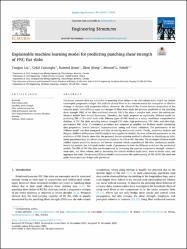| dc.contributor.author | Çakıroğlu, Celal | |
| dc.contributor.author | Liu, Tongxu | |
| dc.contributor.author | Islam, Kamrul | |
| dc.contributor.author | Wang, Zhen | |
| dc.contributor.author | Nehdi, Moncef L. | |
| dc.date.accessioned | 2024-04-04T18:42:15Z | |
| dc.date.available | 2024-04-04T18:42:15Z | |
| dc.date.issued | 2023 | en_US |
| dc.identifier.citation | Çakıroğlu, C., Liu, T., Islam, K., Wang, Z., Nehdi, Moncef L. (2023). Explainable machine learning model for predicting punching shear strength of FRC flat slabs, 301. Elsevier BV. | en_US |
| dc.identifier.uri | https://hdl.handle.net/20.500.12846/1033 | |
| dc.description.abstract | Reinforced concrete slabs are vulnerable to punching shear failure at the slab-column joint, which can initiate catastrophic progressive collapse. The addition of steel fibers in the concrete matrix has emerged as an effective strategy to mitigate such progressive failure. However, the effects of the diverse mixture proportions of the concrete matrix with different types and dosages of fibers have made the accurate prediction of the punching shear strength (PSS) of the fiber-reinforced concrete (FRC) flat slabs a complex task, where the existing mechanical models have several limitations. Therefore, this study proposes an explainable XGBoost model for predicting PSS of flat slabs made with different types of FRC based on a newly established comprehensive database of 251 flat slabs including normal strength FRC slabs, high-performance FRC slabs, and ultra-high-performance FRC slabs. A customized procedure was proposed to establish the XGBoost model considering data preparation, feature selection, hyperparameter tuning and model validation. The performance of the XGBoost model was then compared with that of existing mechanical models. Finally, sensitivity analysis and SHapley Additive exPlanations (SHAP) analysis were applied to identify the most influential parameters on the prediction of PSS. Results show that the proposed feature selection method is effective in identifying six influential parameters from the eleven parameters related to the PSS of FRC flat slabs. The developed XGBoost model yielded highest prediction accuracy and lowest variation, which outperformed the other mechanical models. Sensitivity analysis also indicated similar trends of parameters in both the XGBoost model and the mechanical models. The PSS of FRC flat slabs can be improved by increasing the concrete compressive strength, reinforcement ratio, and fiber volume, and by decreasing the column width-to-depth ratio, water-to-binder ratio, and aggregate size ratio. The proposed XGBoost model could enhance the understanding of PSS of FRC flat slabs and guide future pertinent design code provisions. | en_US |
| dc.language.iso | eng | en_US |
| dc.publisher | Elsevier BV | en_US |
| dc.relation.isversionof | 10.1016/j.engstruct.2023.117276 | en_US |
| dc.rights | info:eu-repo/semantics/openAccess | en_US |
| dc.subject | Slab-column joint | en_US |
| dc.subject | Punching shear strength | en_US |
| dc.subject | Fiber reinforced concrete | en_US |
| dc.subject | High performance concrete | en_US |
| dc.subject | Ultra high-performance concrete | en_US |
| dc.subject | Machine learning | en_US |
| dc.subject | XGBoost | en_US |
| dc.subject | SHAP analysis | en_US |
| dc.title | Explainable machine learning model for predicting punching shear strength of FRC flat slabs | en_US |
| dc.type | article | en_US |
| dc.identifier.volume | 301 | en_US |
| dc.relation.publicationcategory | Makale - Uluslararası Hakemli Dergi - Kurum Öğretim Elemanı | en_US |
| dc.contributor.department | TAÜ, Mühendislik Fakültesi, İnşaat Mühendisliği Bölümü | en_US |

















